
|
Hirsute Reflections: Part 2 With Some Additional Thoughts About Hairs, Fibers, and Bristles Which Will Be Forthcoming In Future Sections Along With a Transitional Leap Into A Further Series On Feathers by Richard L. Howey, Wyoming, USA |
In this essay, I am going to use the topics as an occasion to recount some of my exotic adventures into a variety of remarkable environments–my trip down the Amazon to acquire Macaw feathers, penetration of the Arctic Circle to obtain Caribou hair, my wild and wooly, fair dinkum trek to get some Emu feathers, the expeditions into the Great Plains and mountains of North America to acquire Coyote, Elk, Deer, and Antelope hair, my trip to China to surreptitiously pluck feathers from a Golden Pheasant, the month in Maine to get hairs from the mane of a Moose, the canoe trip down the Orinoco for the exotic parrot feathers, the trip to Scotland to secure some Red Fox hair, the swampy digression into the North American South (as odd as that sounds) to pilfer some Muskrat and Opossum hairs, and, of course, the safari to India for the Peacock feathers. The most remarkable things about these journeys is that they all took place in the comfort and security of the small town of Laramie, Wyoming where I have lived for the past 47 years. So, now you’re disappointed–Get Real! Do you know what it would have cost to go to all of those places? Not to mention having to brave vast hordes of mosquitoes, poisonous snakes, rats, and other sundry vermin, and the further risk of horrific diseases. So, I did what any other elderly, cowardly, true-blue American would do and went to the local shop that stocks hunting and fishing supplies. In many places fishermen still tie their own flies and in shops such as the one I went to, one can find a very nice assortment of packets of feathers and animals hairs. Now clearly I can’t discuss all of this in just one or two essays, so be prepared to have it spread out over several months.
All the ones which I mentioned in the preceding paragraph (and a few other items), I acquired at this shop. However, if there is no such place in your vicinity, there is always eBay where you can find a considerable variety of both feathers and hair. In addition, you may, with a bit of patience, come across a single slide or small collection of slides of animal hairs. This is, by the way, how I acquired the slide of tiger hair. However, as always, do be prepared to encounter the excesses of the fanatic bidder. Another option for a limited selection of slides of animal hairs is biological supply houses. In the last couple of decades, the selection of interesting material on slides from such companies has declined; it almost makes me want to open a biological supply house.
If you were given a packet of 12 different hairs and instructed to identify the animals from which they came, you would be at a loss. The task is made even more difficult by the fact that hairs from different parts of the same animal can show considerable variation. Remember that at least initially, hairs are living, growing organic structures until the cells extend beyond the follicle; they usually have 3 layers and some of these are covered with an exude of an oil secreted by the animal. As a consequence, the preparation and examination of hairs may require special techniques. Polarized light is frequently used and you will very quickly notice that where hairs overlay one another, the color may change dramatically at the crossover points. We shall see some examples of this as we proceed. This is visually quite pleasing, but provides no useful information toward identifying the origin of the hairs. In some instances, degreasing the hairs; that is, using a solvent to remove the oils, may help in discerning morphological details.
I want to begin with a few words explaining my current pre-occupation with hairs bristles, and fibers. I have long been fascinated by the bristles (setae) of marine worms and hope to yet write an article on them. Then 4 or 5 years ago, I got obsessed with beetles and I began to notice all of the sensory hairs they possess (yet another article to be written).
Like most objects which are commonly around us and which we take for granted, hairs are much more complicated than we might imagine. They are composed primarily of the protein keratin and generally have 3 basic areas: the cuticle which is the outer covering 2) a central core called the medulla and 3) the space between the medulla and the cuticle called the cortex. In addition there are various types of granules, the most significant of which visually are a result of melanin which is a pigment.
A couple of years ago, I bought a small collection of slides on eBay (about 30 slides) and then got interrupted by other matters, set them aside, and more or less forgot about them until very recently. I took the slide box they are in out of a cabinet and found to my delight mounted hair samples ranging from Muskrat to Alpaca to Tiger and Monkey–a miniature treasure trove. The mounter was an Englishman named Ernest H. Grant who was elected a Fellow of the Royal Microscopical Society in 1919 and reportedly remained active for some years thereafter. However, other than this meager bit of information, I have not been able to discover anything else about him other than a few descriptions of small slide sets he did which have come up for sale.
Whoever Mr. Grant was, he clearly had access to a wide variety of material from which he produced some very interesting slides. Some that have come up for sale in addition to the hair slides which I purchased are:
1) Five slides of fish parts: Lump Fish scale, Dogfish internal organs, Shark bone section, skin from the underside of a Ray, and a Goldfish scale.
2) Five slides of transverse sections of stem of Maple, Willow Cherry, Elder Camphor, and Elm.
3) Five slides of horns of animals plus one of Whalebone.
4) Nine slides of insects and insect parts.
5) Four insect mounts listed as 19th Century: Foot of Bug, Head of Bug, Let of Cricket, and Skin of Lizard. (I’ll bet it surprised the hell out of herpetologists to learn that lizards were insects.)
6) Three slides of spines of a sea urchin.
7) A slide of spicules of a sea cucumber Holothuria tremula.
8) Three slides of zoophytes.
9) Two slides “water related”; one is chiton, “a primitive marine mollusc” and the other Hydrodictyon, water net, a freshwater alga.
10) Ten slides, all botanical, and a photograph show an image of a transverse section of the anther of a Crown Imperial. How proud my father would have been to have a cross section of his car (excuse me, automobile. A Chrysler Crown Imperial was no mere car, even when like this one, it was an older, well-used model.) Oops! Wrong category. When one Googles, one can end up with all sorts of interesting but not necessarily relevant items. The Crown Imperial that I was seeking is Fritillaria imperialis. It is indeed an impressive bloom and in North American flowers in late spring emits a distinctive odor which helps repel mice and other rodents. A boon to the natural gardener who is trying to avoid using chemicals.
Most of Mr. Grant’s slides were produced in the early 20th Century and display good mounting technique and they remain in good condition after nearly 100 years. Sometimes, in dealing with old slides, one has to become a detective to decipher the handwriting and all of my hair slides by Grant are hand-labeled. On the whole, the handwriting is quite legible, but 2 instances posed minor problems which I was able to resolve, but another label has proved untranslatable and I’ll show it to you and you can solve the problem for me.
Here is what the label looks like.

The other 2 cases were a consequence of my ignorance. There is a slide labeled “Hair of American Fitch”. Now, I do know of Abercrombie and Fitch and the firm was established in 1892 by Abercrombie and then in 1904 Ezra Fitch invested heavily in the company and later become the sole owner. So, perhaps, Mr. Grant was visiting America, made an appointment with Mr. Fitch, distracted him, snuck up from behind and snipped a hair sample. Nice to imagine, but it didn’t happen that way. As it turns out “fitch” refers to a “polecat”, which is a member of the weasel family and quite an attractive animal but with powerful scent glands that makes it wise to keep your distance.
The second case involved a slide labeled “Hair of Kinsky” and I immediately thought of that madman of Herzog’s films–Klaus Kinski but, of course, the spelling is slightly different, but that doesn’t necessarily mean much when dealing with names in Slavic languages. Much of the credit for the breeding of this handsome animal, which as it turns out is a horse, belongs to Count Oktavian Kinsky of Bohemia which is now part of the Czech Republic.
So, maybe, if you’re real nice and send me glowing e-mails praising this essay and asking for more, I’ll show you some Fitch and Kinsky hairs in Part 3. Don’t worry there are plenty of treats in this essay and if you get withdrawal symptoms waiting for next month’s issue of Micscape, you can always compensate by buying tickets to the musical Hair. Alternatively, you can have a bit of the hair of the of the dog that bit you. A bit of sleuthing reveals that this expression dates back to Elizabethan times and was used by, among others, Shakespeare. What’s most intriguing is that the expression is quite literal. It was believed that if you took a bit of hair from the offending animal (a risky enterprise at best) and applied it to the wound, you would thereby be protected from the disease. Rabies, as we now know it, was then defined in terms of symptoms and the awful consequences which the individual once bitten was at pains to avoid. It didn’t of course work on rabies and, so far as I can tell from the reports of my inebriate friends, it doesn’t work for alcohol either.
Well, if you’re quite finished luring me into all these tangents and distractions, perhaps we can proceed to look at a few additional hair samples from animals which, with one exception, can all be found in the general area where I live. Last month, we looked at some bat hair and I’ll give you just one brightfield image here to remind you of its intriguing “zigzag” character.

Let’s begin with the coyote which has a very bad press in these parts. They have a reputation for being cowardly, craven, vicious, sneaky, devious, and duplicitous–in other words, very much like a disturbingly large percentage of our contemporary politicians.


Here the differentiation between the cortex and the medulla is extremely clear.
The next example is a sample from a female Elk and again I’ll show you 2 brightfield images and then a polarized image with the addition of a Red 1 compensator. In neither this case nor with the Coyote does the plane polarized image display anything of interest since the birefringence is very weak, so I have omitted those images.

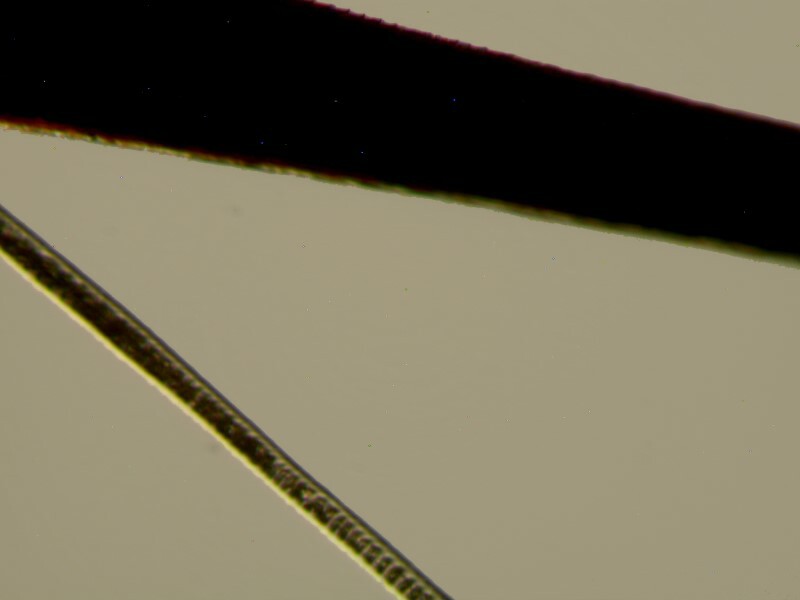

I include the first image to show you that while the hairs are quite thick, they come to a sharp point. The smaller hairs show more differentiation and the Red 1 image allows us a better view of the medulla.
Next in line are hairs from a Muskrat. Nothing especially surprising here, although we do notice that once again we have hairs that vary considerably in thickness. Also, the thick hair, in this case, has a rather slim medulla and a rather thick cortex which might provide an advantage in preserving heat in cold water.

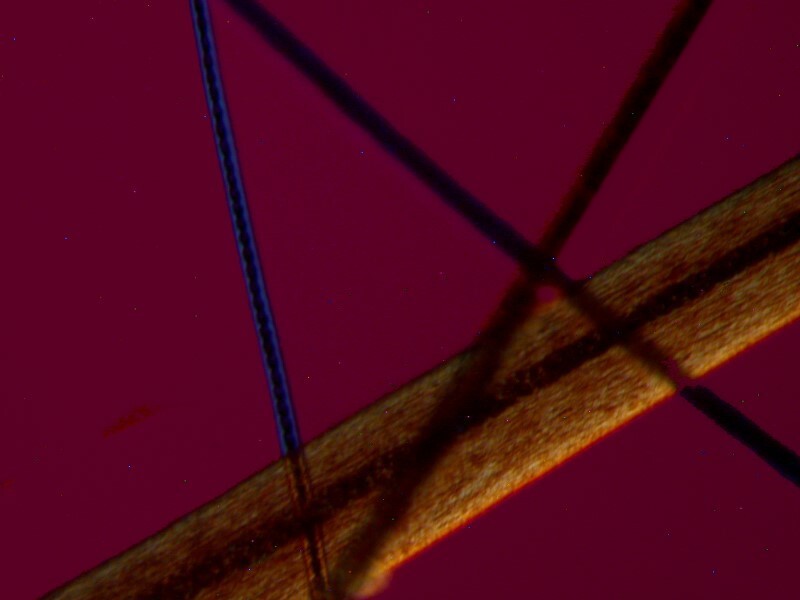
In case you’ve not encountered a Muskrat, here’s what they look like.
Next up is one of my favorite local denizens–the Red Fox. They do not like to be displaced and, in spite of development, they find open spaces where they establish dens. The cubs or “kits’ are irresistibly cute.
They are not aggressive toward humans and, in fact, display a sort of savoir faire trying to tell us that 1) they were here first and b) that they are not particularly impressed by us. One of my friends who built a house with a sizeable plot of land behind it, discovered one afternoon a fox sunning itself on the deck of his porch.

The fox hairs are interesting although not especially impressive and show virtually no birefringence. I’ll show you 2 brightfield images–a wide view and a close-up.
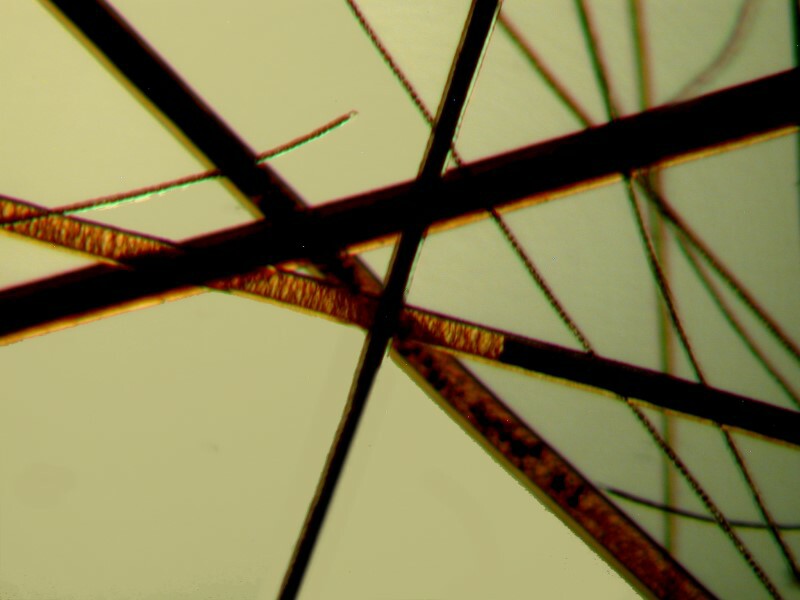
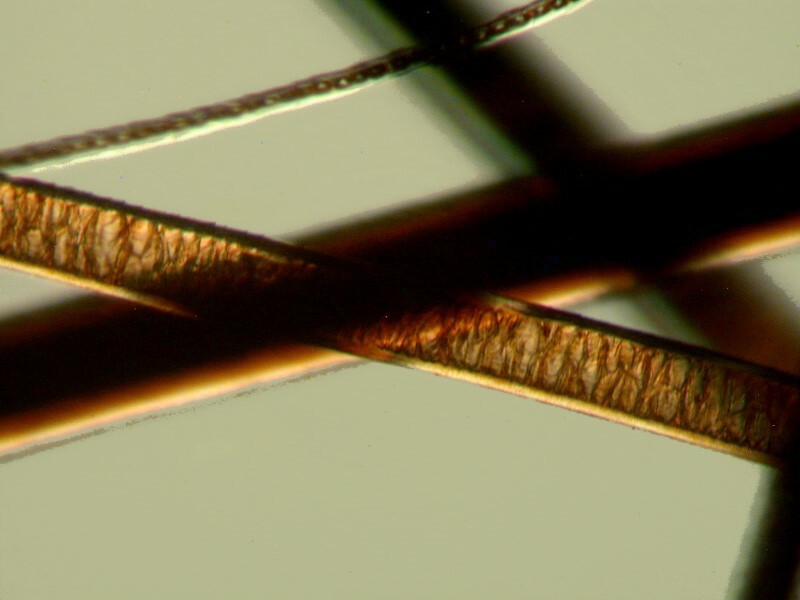
Now, we get to the one critter that is not be found locally and that is the Opossum. These are intriguing animals because they are marsupials. They fall a bit short of being cute like foxes and hedgehogs, but they are certainly several cuts above sloths which are interesting, but not something I’d want to hug. So, here’s an Opossum.
My Opossum hair sample, as it turns out, is quite striking, so I think it must have come from Pogo. Below is a brightfield view and a polarized image, both of which I find quite pleasing. Just look at the gorgeous variety of colors.

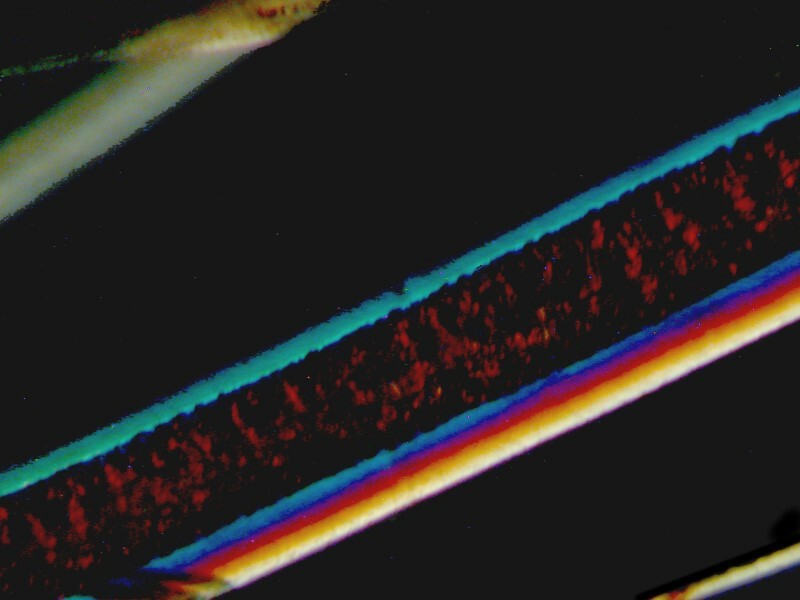
And, in conclusion, (do I hear sighs of relief?), some hairs of Artheneus. (I can hear your pulse racing.) Actually these fascinating bristles come from a rather unpleasantly invasive little creature–a dermestid beetle, also known as a carpet beetle. And, be warned, if you have any collections of butterflies, beetles, quilts, fabrics, fine rugs, etc., be sure to take precautions to protect them against these seemingly omnivorous little nasties. So, you may have to resort to mothballs, thymol crystals, or, my favorite, cedarwood oil. Don’t deceive yourself that because you have your insect collection sealed in Riker mounts, it’s protected. I have found dermestids in glass, screw-capped vials that I would have sworn were “invialable”[sic] (Sorry about that.). However, it’s no joke; if you have collections which you prize, regardless of whether or not they have financial value or are simply of value for your interests, then for your own peace of mind, protect them against these miniature horrors with beautiful bristles. I’ll show you 2 brightfield images, the second being a close-up. These look like micro-spears (probably used in productions of Verdi’s Micro-Aida) and notice that the shafts are intricately barbed.
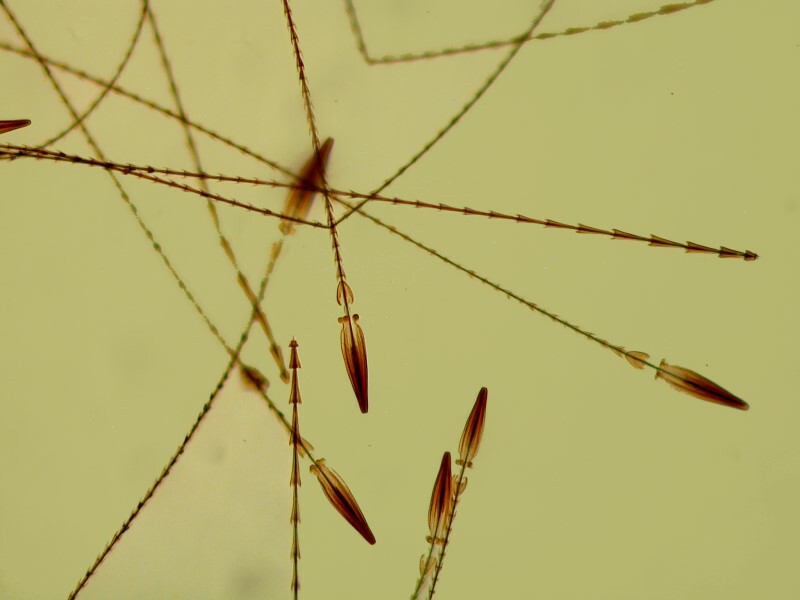
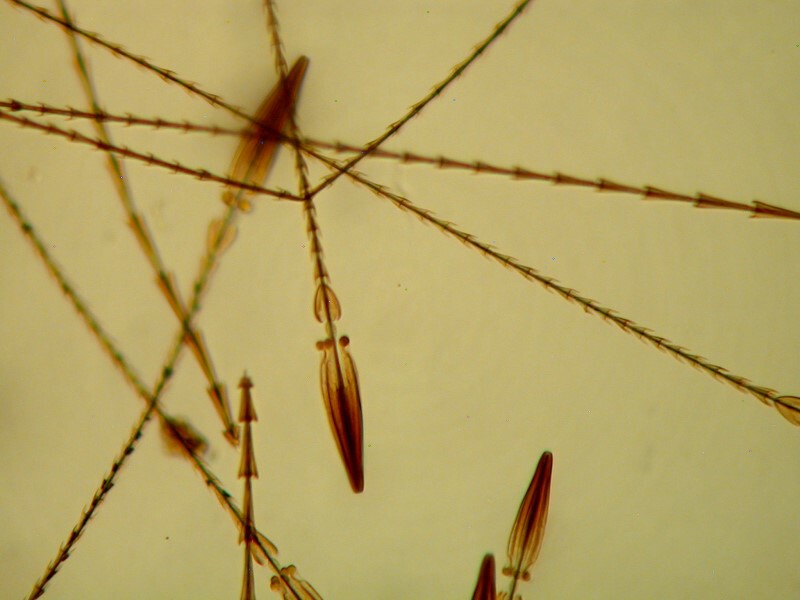
See you next month, if I get enough accolades (2 or 3 would be good).
All comments to the author Richard Howey are welcomed.
Editor's note: Visit Richard Howey's new website at http://rhowey.googlepages.com/home where he plans to share aspects of his wide interests.
Microscopy UK Front
Page
Micscape
Magazine
Article
Library
Published in the October 2013 edition of Micscape Magazine.
Please report any Web problems or offer general comments to the Micscape Editor .
Micscape is the on-line monthly magazine of the Microscopy UK website at Microscopy-UK .
©
Onview.net Ltd, Microscopy-UK, and all contributors 1995
onwards. All rights reserved.
Main site is at
www.microscopy-uk.org.uk .